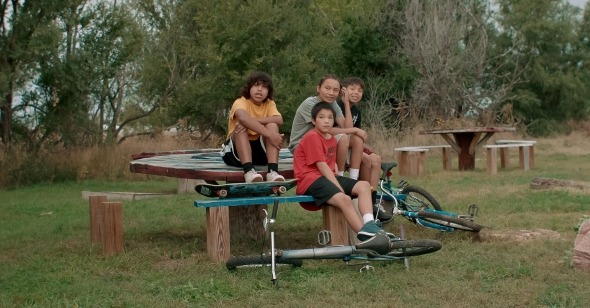The World Within
By Chris Shields
War Pony
Dir. Gina Gammell and Riley Keough, U.S./U.K., Momentum Pictures
Gina Gammell and Riley Keough’s feature film debut, War Pony presents a grim and naturalistic vision of life for Oglala Lakota people on the Pine Ridge Reservation in South Dakota. The world to which the viewer is granted entrance is totalizing, offering no easy escape from the tragic realities of day-to-day survival among a people that have been systematically exterminated, displaced, and exploited by white supremacy. These crimes are not confined to history—we watch the exploitation continue as young Native American men and women have their most immediate resources, their bodies and labor, taken from them through banal, dehumanizing capitalist coercion. War Pony is a delicately acted and beautifully shot film that daringly confronts viewers with ugly truths about the ongoing effects of a legacy of neglect and violent oppression.
Two parallel narratives play out in War Pony. There is the story of Matho (LaDainian Crazy Thunder), a young boy who steals meth from his father to sell. After being choked by the man and then thrown out, Matho finds refuge with a woman who is housing a number of Native boys. Soon he is dealing drugs in return for room and board. Eventually he is caught and finds himself homeless once again. Matho’s friends help him set up a little home in an abandoned house, but a drug and alcohol fueled joyride in a stolen car leaves him wandering and confused.
The other narrative follows Bill (Jojo Bapteise Whiting), a man with two children who is estranged from the mothers of both. He cruises around the “res” taking calls on his cellphone as he attempts to make money selling anything he comes across. After finding a poodle tied up outside his house, he brings it back to its owner and makes a deal to buy it with the intention of breeding and selling puppies. Another chance encounter leads him to work for a white man (Sprague Hollander). Bill does odd jobs, packages turkey jerky, and transports young native women to and from sexual encounters with his boss. When Bill’s boss asks him to work as a waiter at his Halloween party, the young man brings along his dog. After the dog attacks one of the turkeys, it’s killed, and the resulting fight causes Bill to lose his job.
The squalid reality is so immersive that the film intentionally makes the forest difficult to see from the trees. We witness drug dealing, drug use, child abuse, and child neglect, behaviors that would seem to encourage the viewer to look away. Yet as the film continues, subtle structural and poetic dimensions emerge. Bill’s story provides the turn that gives a more explicit and pointed meaning to what we’ve seen. After losing his job and being denied his unpaid wages, the young man and his friends rob the turkey farm, breaking into the company’s safe and taking the birds. The film ends with the turkeys running wild back on the reservation in a moment of poignant metaphoric and literal rebellion. The birds, which have long been false symbols of peace and cooperation between indigenous people and their white colonists, now represent genocidal betrayal—an invitation rescinded.
The seeds of this rebellion are planted throughout the film. When we first encounter Bill he is driving through the “res” slumped low in his seat. Out the car window, we see horses galloping alongside him. The image forces the audience to confront a young Native American man with face tattoos listening to mumbled hip-hop against the backdrop of another, older vision of native life. It’s a potent moment of cognitive dissonance and one of the film’s most brilliant, asking us why we can valorize America’s indigenous people of the past while ignoring them in the present. Other more obvious images point toward a deeper consciousness, like when Matho and Bill see a phantom buffalo. A more effective example, however, is the funeral of Matho’s father, where an eagle flies high above the procession of cars as the young man joins in his people’s reverential cries.
War Pony is incisive without being dramatically contrived, an impressive feat that seems to have much to do with the long and collaborative process of its making. The film was written by Gammell and Keough along with the Native American men Franklin Sioux Bob and Bill Reddy, who based the script on incidents from their own lives. The film indeed feels emotionally authentic, and while its narrative runs the risk of being a litany of heartbreaking moments, its unparalleled specificity and peerless performances, particularly the two non-actor leads, preserve its integrity. There is hope in the film, and there is rebellion, and while it's painful getting there, in the end, a deeper, more patient spirit prevails and soars.
